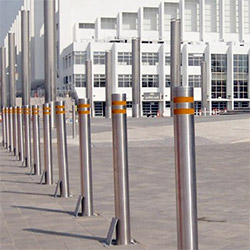From bustling city streets to car parks, shopping centres and, safety bollards are a common sight in our everyday life.
They play a pivotal role in enhancing security, safeguarding pedestrians, and managing traffic flow – but they also have a fascinating history.
In this article, we’re sharing 8 interesting facts about safety bollards, including where the word comes from, what the first bollards were made of, and how they became key security staples.
What are bollards used for?
A bollard is a short, sturdy, vertical post used for controlling road traffic, prevent collisions, and protect pedestrians, buildings and other structures.
The term originally referred to a post on a ship or quay, used principally for mooring boats.
Fun facts about safety bollards
1. Where does the word ‘bollard’ come from?
The word ‘bollard’ likely comes from an Old Norse word from the 14th century: ‘bole’, which means tree trunk.
The Oxford English Dictionary, however, says that the earliest known written use of the word ‘bollard’ can be found in the 1844 writings of lieutenant (and later admiral) Astley Cooper Key, of the Royal Navy.
2. The first bollards were used to secure ships to land
The connection to Admiral Key and the Navy is important because bollards were originally used as mooring posts for ships.
Dating back at least 200 years, maritime bollards made of wood, iron or stone could be found dotted along quaysides. Sailors would then secure their ship’s mooring ropes to these posts.
3. Captured French cannons were used as bollards in London
During the 1800s, the British navy captured many French warships and stripped the French boats for anything of value – including their cannons.
However, most of these were too large to be retrofitted on the British ships, so they were put to use as mooring bollards on London’s riverside. The barrel end of the cannon was buried in the ground and a cannon ball inserted in the muzzle to plug the gap.
The style proved so popular that once the French cannons had all been used, replicas of the cannon shaped bollards with a rounded top were commissioned and installed throughout the city.
In fact, some of the original cannon bollards can still be found on London’s South Bank today!
4. The first traffic safety bollards
Traffic and parking bollards have been used since at least the beginning of the 18th century.
The first confirmed installation of traffic bollards was that of two oak posts, which were set up next to the medieval Eleanor cross at Waltham Cross, Hertfordshire, in 1721 with the specific intent to “secure Waltham Cross from injury by Carriages”.
Five stone bollards are also pictured protecting pedestrians from traffic in Canaletto’s painting ‘The Arch of Septimius Severus’, finished in 1742.
5. Wood, stone, iron, steel and polymer
In the past, wood and stone bollards were sufficient for protecting pedestrians from horse-drawn carriages and early bicycles.
However, with the introduction of cars and lorries to everyday life, the materials used in safety bollards has evolved.
Modern safety bollards are mostly constructed from more durable materials such as steel and polymer, which provide a higher level of security for today’s urban environments.
6. Three installation methods
There are three main methods for installing a safety bollard. These are:
- Dig-in bollards: These bollards are permanently fixed to the ground by digging a hole and securing the post with concrete.
- Bolt down bollards: Offering flexibility, these bollards are secured to the ground with heavy anchors, making them ideal for temporary safety needs.
- Telescopic bollards: Retractable bollards are the most complex to install as they involve creating a foundation, mounting the bollard, and integrating electronic control systems for access control.
The choice of installation method depends on factors such as site conditions, security requirements, and the need for flexibility. Proper installation is crucial to ensure the effectiveness of bollards in enhancing safety and security.
Talk to CT Safety Barriers today about your bollard installation needs.
7. UK bollard regulations
Bollards are a great way to help prevent ram attacks and protect people, without negatively impacting pedestrian flow.
To meet security requirements, the UK government requires bollards to be positioned with a maximum gap (between bollards) of 1.2 metres.
Organisations must consider all aspects of pedestrian movement when planning where to place bollards, including route capacity, comfort, convenience, conflict, and wheelchair accessibility.
8. Works of art
As well as providing high levels of safety and security for drivers and pedestrians, safety bollards are often used as a form of street art.
Many cities have decorative and creatively designed bollards that don’t just serve a functional purpose but also enhance the visual appeal of public spaces.
- In 2005, Winchester City Council funded the painting of 16 bollards in the city centre. Designs included famous works of art such as Da Vinci’s Mona Lisa and Claude Monet’s
- To celebrate the Queen’s Jubilee in 2023, an artist in Cornwall painted six bollards outside a community garden to represent the Queen’s Guards, complete with red uniform and bear skin hats.
- More than 100 painted bollards line the streets of Geelong, Australia, guiding visitors and protecting pedestrians from collisions. Each bollard is designed to represent people from the city’s past.
Contact CT Safety Barriers today for all your security bollard needs.

